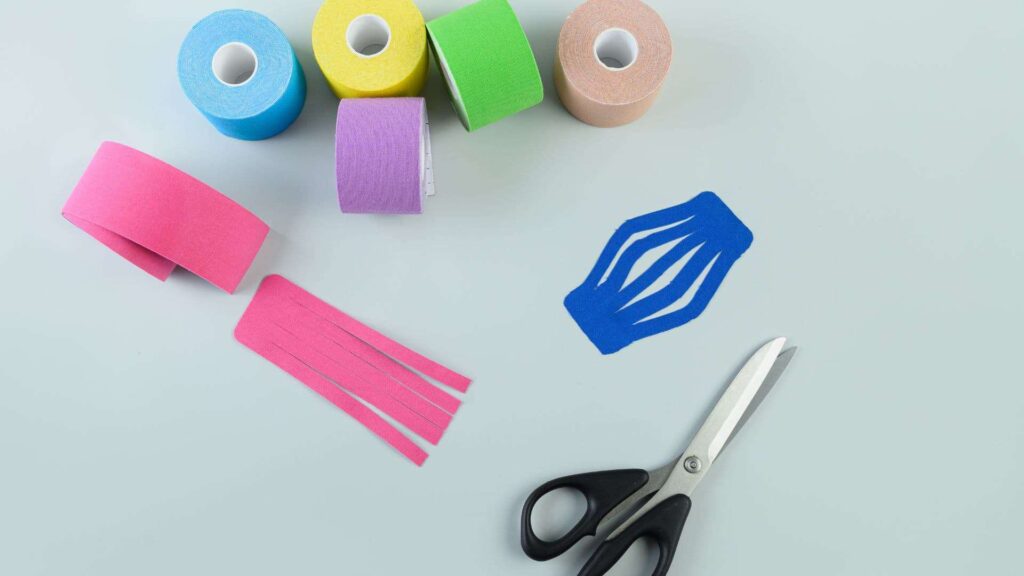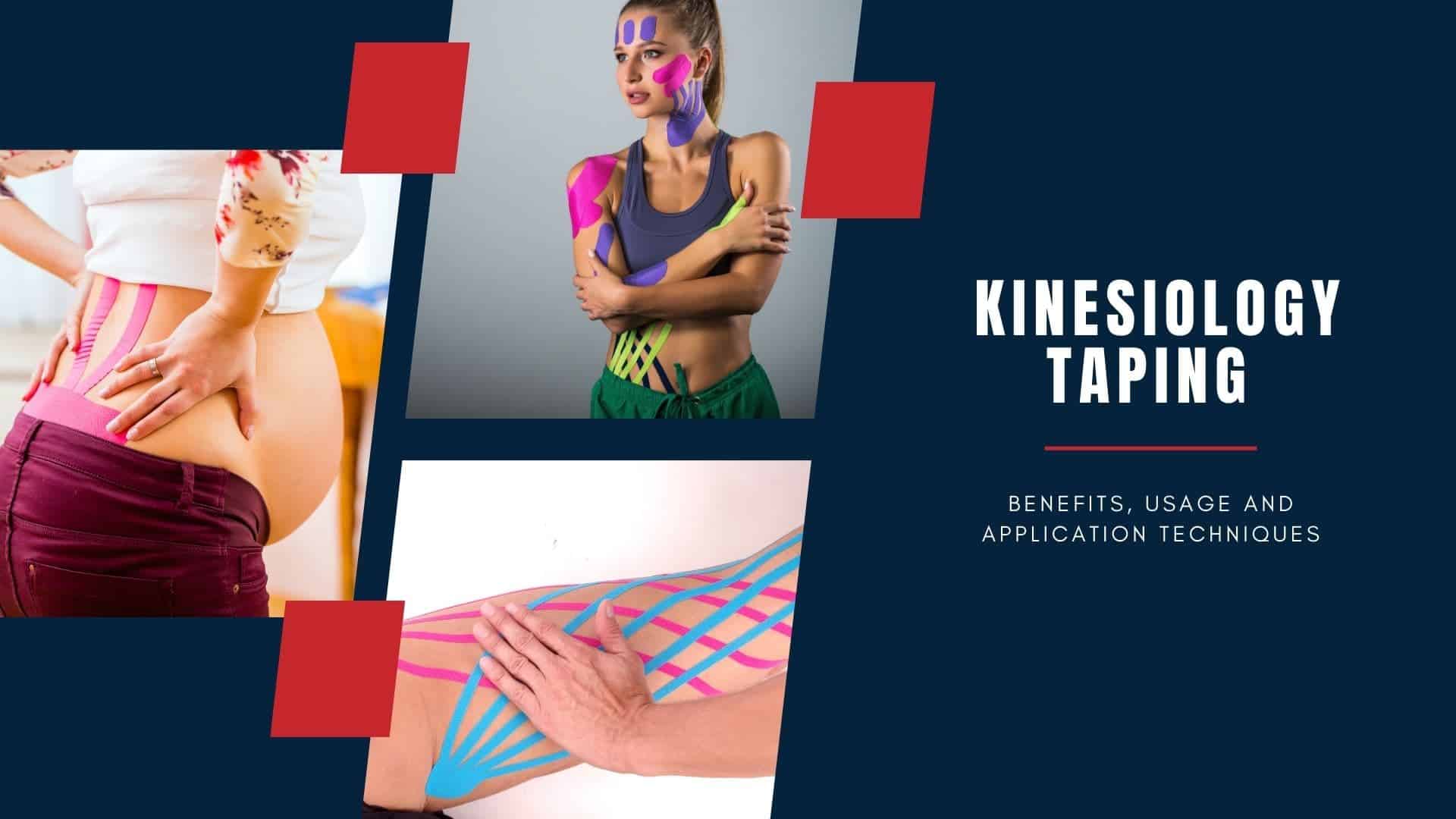Kinesiology Taping Benefits, Usage and Application Techniques: A Comprehensive Guide
Feeling aches and pains from your daily tasks, workouts or sporting activities? Here’s an interesting fact: kinesiology taping, often used by professionals, can relieve muscle pain and take your activities to the next level!
This comprehensive guide delves into the world of kinesiology taping – exploring its numerous benefits, from pain management to injury prevention and even posture correction.
Ready to take control of your life? Let’s unravel this tape together!

Key takeaways
- Kinesiology taping is a non-invasive technique that involves applying specialized tape over muscles and joints to enhance their stability while improving circulation.
- Kinesiology tape leverages the body’s innate healing power by gently lifting the skin to temporarily increase interstitial space for improved blood flow and lymphatic circulation.
- The benefits of kinesiology taping include pain relief, improved athletic performance, injury prevention, rehabilitation, posture correction, and swelling reduction.
- Kinesiology taping can improve gait function, decrease swaying in normal posture, and support the muscles, during any day-to-day activities, including sports like soccer, basketball, football, rugby, racquet sports, and running.
- Conditions that benefit from kinesiology taping include sports injuries, muscle strains, joint pain and instability, post-surgical recovery, and poor posture.
- Proper application techniques include starting with clean, dry skin; choosing the right technique for specific needs; applying proper tension; rounding the edges of the tape; rubbing to activate adhesive; and removing carefully.
- Overall, kinesiology taping is a versatile tool that can enhance performance while providing support.

What is kinesiology taping?
Kinesiology taping, also known as therapeutic taping, is a technique that involves applying a specialized tape to the muscles and joints to provide support, improve circulation, and aid in injury prevention and rehabilitation.
Definition and origin
Kinesiology taping, a revolutionary therapeutic tool used in various rehabilitation fields, owes its inception to Dr. Kase. He crafted a specialized blend of cotton and nylon tape to mimic the skin’s properties, thus birthing the Kinesio Taping Method.
This therapeutic tool often comes into play in programs such as pediatrics, geriatrics, orthopedics, neurology, and oncology. These applications leverage the kinesiology tape’s ability to enhance circulation and lymphatic drainage, which helps reduce swelling and inflammation.
Initially introduced as a product exclusive to chiropractic care, this non-invasive therapy method quickly resonated with healthcare professionals globally for its potential advantage in pain management and rehabilitation.
Today, you can find several types and colours of kinesiology tape tailored to individual needs and preferences.

How does therapeutic taping work?
Kinesiology taping works in a simple yet effective manner – it facilitates the body’s natural healing process while offering support to muscles and joints without restricting one’s range of motion.
The robust yet stretchy material aids in pain reduction and supports joints and muscles by resisting overstretching of the ligaments and tendons without restricting the range of motion.
With no medicine or active ingredients contained within it, the therapeutic tape also facilitates manual lymph drainage.
It counteracts the negative effects of inflammation by gently lifting the skin and creating space for improved blood flow and lymphatic circulation underneath.
Unlike regular white medical or athletic tape that might restrict movement, this type enhances normal movements and reinforces correct motor patterns.
In sports medicine especially, it is acclaimed for delivering key benefits, including pain management, protection of vulnerable areas, and increased sensory input for better proprioception – all contributing towards improved performance on the field or off.

Benefits of kinesiology taping
Kinesiology taping offers a range of benefits, including pain relief, improved athletic performance, injury prevention and rehabilitation, posture correction, and swelling reduction.
Pain relief
Kinesiology taping is a resourceful solution to pain relief. This technique utilizes multiple strategies to manage pain, including but not limited to reducing inflammation, masking pain signals, and minimizing joint grinding.
As a result of gently lifting the skin, interstitial spaces are expanded around inflamed areas. Compression caused by local inflammation is then alleviated, erasing the pain caused by pressure on the surrounding tissue.
With its unique design, kinesio tape applies gentle pressure on the skin, stimulating mechanoreceptors that compete and interfere with pain receptors to reduce pain sensations. The result is decreased discomfort, allowing for a noticeable improvement in physical performance.
Creating space in joints and preventing them from rubbing against each other, taping also protects weak areas prone to injury, causing painful episodes. Thus, therapeutic taping offers an effective natural and non-invasive pain management method.

Improved athletic performance
Kinesiology taping has been shown to enhance athletic performance in various ways. It provides muscle support, which helps prevent fatigue and allows athletes to perform at their best for longer periods of time. It can also enhance or inhibit muscle function to make more use of healthy muscles while shielding injured ones.
Taping from a muscle’s origin to insertion will create an additional pulling force in the same direction the muscle will naturally contract. This facilitates the action of the healthy muscle and can be used to increase the muscle’s natural effect. A tested usage of this technique in improving arch support, for example, is to improve balance by facilitating the actions of the tibialis anterior, tibialis posterior, and peroneus longus, all while supporting the transverse arch.
On the other hand, taping from insertion to origin will create an opposing force to the muscle’s natural action. This will protect against overstretching of the muscle. A common use for this technique would be restricting peroneus longus during sport. Peroneus longus is the most common muscle injured in an inversion ankle sprain, the most common injury in healthy, active individuals.
The K-tape also enhances sensory input, improving proprioception and allowing athletes to control their movements better. Additionally, taping can aid fatigue recovery by increasing blood and lymphatic flow, promoting faster removal of waste byproducts created during exercise and reducing muscle soreness caused by this waste buildup.
With the added benefits of pain reduction and improved range of motion, it’s no wonder why many Olympic and professional athletes turn to therapeutic taping for that extra edge on the field or court.
Injury prevention and rehabilitation
Kinesiology therapeutic taping is highly effective for injury prevention and rehabilitation. By supporting the normal activity of muscles and joints, it helps to reduce the risk of injury during physical activity and improve balance to reduce the risk of injury from falls.
Taping enhances proprioception, which is the body’s awareness of its own position and movement in space. This increased proprioception helps to improve balance and stability, making it less likely that you’ll strain or sprain a muscle or suffer a fall.
In terms of rehabilitation, elastic therapeutic tape can help speed up the healing process after an injury. It promotes circulation to the affected area, which brings essential nutrients and oxygen needed for repair.
Additionally, its greater elasticity prevents overstretching of injured muscles without limiting the range of motion. This allows for functional movement while protecting the injured area from further damage.
Posture correction
Kinesiology taping can be a helpful tool for correcting posture and improving overall alignment. By gently taping areas of the body that veer away from correct posture, kinesiology tape provides support to help return the body to proper alignment.
This can be particularly beneficial for those who struggle with maintaining good posture throughout the day or during physical activities. Proper taping techniques with kinesiology tape can help activate and engage specific muscles, providing stability and support to maintain a more aligned posture. Using the Kinesio tape to maintain an ideal posture helps train your muscles to maintain that posture even when you are not using the tape, providing lasting results.
Improved posture enhances physical appearance, helps prevent muscle imbalances, reduces strain on joints, and decreases the risk of injuries. Ideal posture will also allow for better muscle biomechanics, leading to greater contractile strength and, thus, significantly improved performance.
Swelling reduction
Therapeutic tape is a popular tool for reducing swelling and inflammation. The tape creates spaces in the joints, allowing for improved circulation of blood and fluids. This increased blood flow helps remove congestion and promote the healing process, ultimately reducing swelling.
In addition, kinesiology tape can stimulate bruise and contusion recovery and prevent or alleviate muscle fatigue and cramps. Kinesiology taping offers an effective solution for those looking to recover from injuries or manage chronic conditions by providing support to joints and muscles, relieving pain, and reducing swelling and inflammation.

Conditions that benefit from kinesiology taping
Kinesiology taping benefits various conditions, including sports injuries, muscle strains, joint pain and instability, and post-surgical recovery.
Sports injuries
Sports injuries are common among athletes, ranging from muscle strains to joint pain and instability. Kinesiology taping has been widely used as a beneficial technique to aid in recovering and preventing these injuries.
Kinesiology tape helps athletes continue their training while reducing the risk of further damage by providing structural support for weak or injured muscles and joints. Additionally, kinesiology tape can improve circulation, reduce swelling, and alleviate pain associated with sports-related injuries.
From back pain relief to knee rehabilitation, this versatile tool has become essential to both professional rehabilitation programs and athletic performance enhancement strategies.
Muscle strains
Muscle strains are a common injury that can benefit from therapeutic taping. Whether it’s due to overuse, improper technique, or sudden movements, muscle strains can cause pain and limited mobility.
Kinesio therapeutic tape provides support and stability to the affected muscle, which can help reduce further damage and support the healing process. Applying tape to the strained area helps improve circulation, accelerates healing, and provides additional support during physical activities.
It can allow individuals with muscle strains to continue their daily activities while minimizing pain and preventing further injury.
Joint pain and instability
Kinesiology taping can benefit individuals suffering from joint pain and instability. The tape supports the joints, helping stabilize them and reduce discomfort.
Additionally, kinesiology tape increases sensory feedback, giving individuals a better sense of where their joints are in space and improving overall stability. Whether it’s knee arthritis or shoulder instability, kinesiology taping can provide the necessary support to alleviate pain and improve joint function.
Post-surgical recovery
Post-surgical recovery can be challenging and painful, but taping offers a favourable solution. This therapeutic technique helps improve circulation, support muscles, and help post-surgical recovery.
It has particularly benefited patients recovering from surgeries, as it reduces swelling and improves surgical outcomes. Kinesiology tape is essential in postoperative treatment by modulation of pain and promoting proper tissue alignment.
Whether aiding in rehabilitating musculoskeletal conditions or facilitating neurological recovery, therapeutic taping is a valuable tool for patients seeking a faster and more effective path to recovery after surgery.

How to apply kinesiology tape?
To apply kinesiology tape, start by preparing the skin with a thorough cleaning to remove any oils or lotions. Then, cut the tape into the desired length and shape based on the treated area.
Next, stretch and apply the therapeutic tape directly onto the skin with light pressure, ensuring it adheres smoothly without wrinkles or gaps. Finally, avoid excessive stretching of the tape’s ends and be mindful of its duration and frequency of use for optimal effectiveness.
Preparation and cleanliness
Proper preparation and cleanliness are essential when applying kinesiology tape. Before starting, it is important to ensure that the area where the tape will be applied is clean and dry.
This helps to maximize the adhesive’s effectiveness and prevent any potential skin irritation or infection. Additionally, shaving excess hair from the area can help improve adhesion.
When removing any oils, lotions, or sweat from the skin, it is recommended to use an alcohol wipe or a mild soap and water solution.
Techniques and tips
Here are some techniques and tips for applying kinesiology tape:
- Start with clean, dry skin: Make sure the area where you apply the tape is free from dirt, oils, and lotions. This will help the tape adhere better and stay in place.
- Choose the right technique: There are various techniques for applying kinesiology tape, such as fan cuts, Y shapes, or X shapes. Each technique is designed to target different areas or provide specific support. Choosing the right technique for your injury or pain is crucial for effective results.
- Apply proper tension: When applying the tape, stretch it to the appropriate tension level. Too much tension can restrict movement and circulation, while too little tension may not provide enough support. Finding the right balance is key.
- Round the edges: To prevent the corners of the tape from peeling up prematurely, round off the edges before application. This will help ensure that the tape stays in place longer.
- Rub and activate adhesive: Once applied, rub your hand over the tape to activate the adhesive and improve adherence. This will help ensure that the tape stays in place during physical activity.
- Remove with care: Remove the kinesiology tape slowly and gently, rolling it to avoid irritating or damaging the skin. Pulling it off too quickly can cause discomfort or leave residue behind.
Duration and frequency of use
The duration and frequency of kinesiology tape use can vary depending on the individual and their specific needs. Generally, it is recommended to leave the tape applied for around 24-48 hours at a time due to the constantly changing physical condition of the body.
This allows for continuous support and stimulation of the targeted area. However, it is important to note that the kinesiology taping should be removed if any irritation or discomfort occurs. Additionally, it is advisable to consult with a healthcare professional to ensure proper application and guidance on how often to use the tape for optimal results and effectiveness in managing pain, improving performance, preventing injuries, or aiding in rehabilitation.

Taping by professionals
Taping applied by physiotherapists, chiropractors, trainers, and professional kinesiologists can help in the following ways:
Assessment: They can assess the injury or pain and determine how to apply the tape to support and promote healing.
Application: Professionals can apply the tape correctly to ensure it provides the necessary support and does not cause further injury.
Education: They can educate the patient on properly caring for the taped area and safely removing the tape.
It is important to note that kinesiology taping is most effective when used along with other conventional treatment methods.
Support, Stability, and Healing Facilitation
In conclusion, therapeutic taping offers many benefits and uses for active people, athletes and those with various musculoskeletal conditions. From pain relief to improved athletic performance, this tape provides support and stability and facilitates healing.
Whether recovering from an injury or looking to enhance your sports performance, kinesiology taping is worth considering as a valuable tool in your rehabilitation or training toolkit.
Frequently Asked Questions
1. What are the benefits of kinesiology therapeutic taping?
Kinesiology therapeutic taping provides various benefits, including pain relief, support for injured muscles or joints, improved circulation and lymphatic drainage, enhanced athletic performance, and reduced muscle fatigue.
2. How does therapeutic taping work?
Therapeutic tape lifts the skin slightly to create space between the muscle and underlying tissues. This helps improve blood flow and lymphatic drainage while reducing pressure on pain receptors.
3. Can anyone use kinesiology tape?
Yes, anyone can use kinesiology tape if they follow proper application techniques and consult with a healthcare professional if they have specific medical conditions or injuries requiring additional attention.
4. What are some common uses for therapeutic taping or kinesiology taping?
Taping is commonly used in sports medicine to treat sprains, strains, tendonitis, and knee injuries. It can also be used for post-surgical recovery, chronic pain management, and enhancing athletic performance during training or competition.







